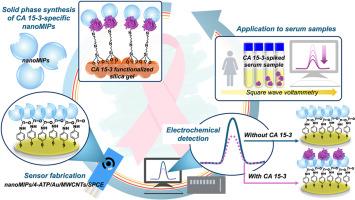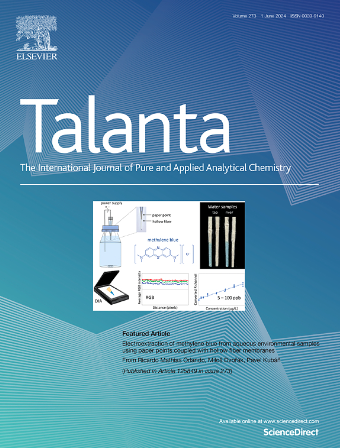用于乳腺癌监测的ca15 -3特异性分子印迹聚合物纳米颗粒伏安传感器
IF 6.1
1区 化学
Q1 CHEMISTRY, ANALYTICAL
引用次数: 0
摘要
癌症抗原15-3 (CA 15-3)是乳腺癌的重要生物标志物,用于监测疾病的严重程度和复发。此外,它的检测对术后治疗是有益的。因此,能够追踪患者体内CA 15-3水平的生物传感器将为疾病监测提供有用的数据。本研究提出了分子印迹聚合物纳米颗粒(nanoMIPs)特异性检测CA 15-3;此外,将合成的纳米omip与电化学传感器结合用于乳腺癌监测。采用固相法合成了ca15 -3特异性纳米omip。为了提高传感器的灵敏度,采用多壁碳纳米管和金纳米颗粒装饰丝网印刷碳电极(SPCE)。4-氨基噻吩(4-ATP)通过与1-乙基-3-(3-二甲氨基丙基)碳二亚胺(EDC)的反应使合成的ca15 -3特异性纳米omip连接到电极上。通过扫描电镜(SEM)、能量色散x射线能谱(EDX)和电化学方法表征表明SPCE表面改性成功。采用方波伏安法(SWV)对传感器检测ca15 -3的性能进行了评价。该传感器对CA 15-3的检测范围为1 ~ 100 U/mL,检测限(LOD)为0.14 U/mL。检测范围覆盖CA 15-3的参考水平(30 U/mL),可区分健康人与患者。该传感器可以准确可靠地测定预处理后血清样品中的CA 15-3浓度。此外,所提出的传感器在易于制造和检测,低成本和一次性方面具有优势。因此,它可以作为乳腺癌监测的替代设备。本文章由计算机程序翻译,如有差异,请以英文原文为准。

CA 15-3-specific molecularly imprinted polymer nanoparticles-based voltammetric sensor for breast cancer monitoring
Cancer antigen 15-3 (CA 15-3) is a critical biomarker for breast cancer, used to monitor disease severity and recurrence. Furthermore, its detection can be beneficial in post-operative treatment. Thus, biosensors that can track CA 15-3 levels in patients would provide useful data for disease monitoring. This study proposed molecularly imprinted polymer nanoparticles (nanoMIPs) specific for CA 15-3 detection; furthermore, the synthesized nanoMIPs were combined with an electrochemical sensor for breast cancer monitoring. The CA 15-3-specific nanoMIPs were generated via solid-phase synthesis. For sensor fabrication, a screen-printed carbon electrode (SPCE) was decorated with multi-walled carbon nanotubes and Au nanoparticles to improve the sensitivity. 4-aminothiophenol (4-ATP) enabled linking the synthesized CA 15-3-specific nanoMIPs to the electrode via the reaction with 1-ethyl-3-(3-dimethylaminopropyl)carbodiimide (EDC). Characterizations via scanning electron microscopy (SEM), energy-dispersive X-ray spectroscopy (EDX), and the electrochemical method suggested the successful modification of the SPCE surface. Square wave voltammetry (SWV) was used to evaluate the sensor's performance in detecting CA 15-3. The sensor exhibited a wide detection range from 1 to 100 U/mL of CA 15-3 and a limit of detection (LOD) of 0.14 U/mL. The detection range covered the reference level (30 U/mL) of CA 15-3, allowing for distinguishing between healthy people and patients. The sensor allowed for the accurate and reliable determination of CA 15-3 concentrations in serum samples after pretreatment. In addition, the proposed sensor offers advantages in terms of easy fabrication and detection, low costs, and disposability. Therefore, it could serve as an alternative device for breast cancer monitoring.
求助全文
通过发布文献求助,成功后即可免费获取论文全文。
去求助
来源期刊

Talanta
化学-分析化学
CiteScore
12.30
自引率
4.90%
发文量
861
审稿时长
29 days
期刊介绍:
Talanta provides a forum for the publication of original research papers, short communications, and critical reviews in all branches of pure and applied analytical chemistry. Papers are evaluated based on established guidelines, including the fundamental nature of the study, scientific novelty, substantial improvement or advantage over existing technology or methods, and demonstrated analytical applicability. Original research papers on fundamental studies, and on novel sensor and instrumentation developments, are encouraged. Novel or improved applications in areas such as clinical and biological chemistry, environmental analysis, geochemistry, materials science and engineering, and analytical platforms for omics development are welcome.
Analytical performance of methods should be determined, including interference and matrix effects, and methods should be validated by comparison with a standard method, or analysis of a certified reference material. Simple spiking recoveries may not be sufficient. The developed method should especially comprise information on selectivity, sensitivity, detection limits, accuracy, and reliability. However, applying official validation or robustness studies to a routine method or technique does not necessarily constitute novelty. Proper statistical treatment of the data should be provided. Relevant literature should be cited, including related publications by the authors, and authors should discuss how their proposed methodology compares with previously reported methods.
 求助内容:
求助内容: 应助结果提醒方式:
应助结果提醒方式:


